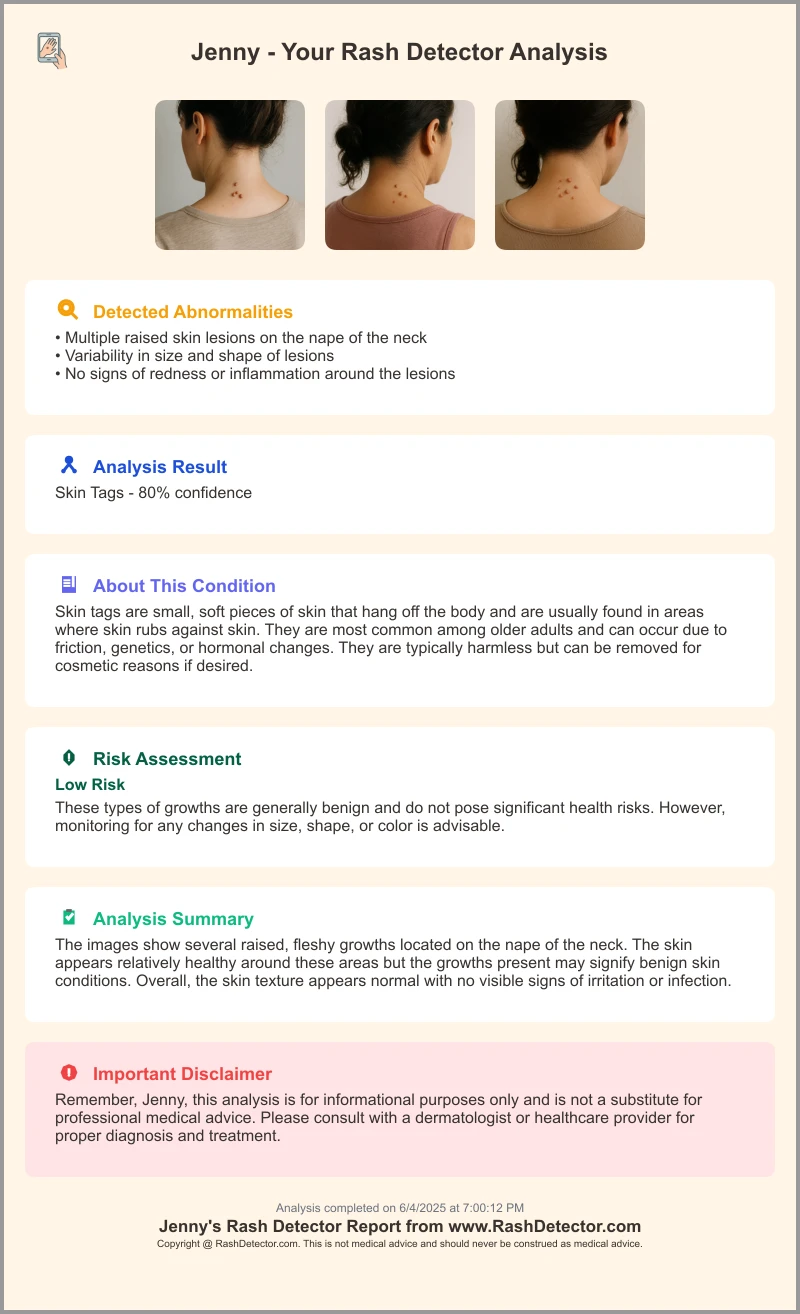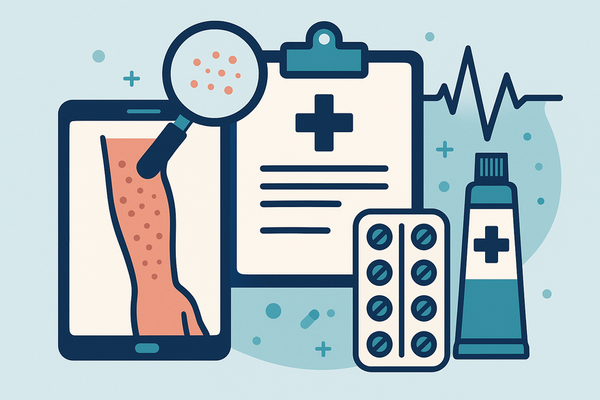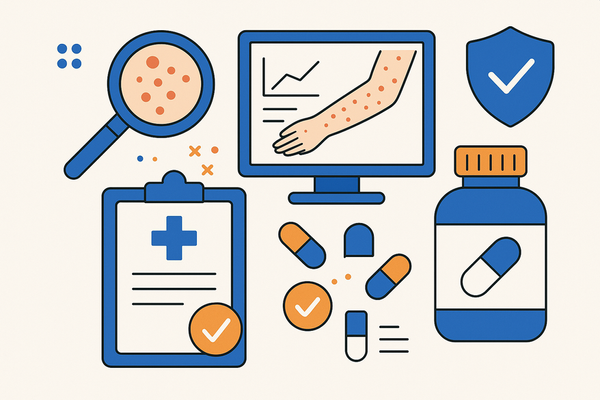Medication Rash Treatment: A Comprehensive Guide to Managing Medication-Induced Rashes
Explore effective medication rash treatment options in our comprehensive guide. Identify symptoms, risk factors, and management strategies for medication-induced rashes.

Estimated reading time: 7 minutes
Key Takeaways
- Recognize symptoms from mild redness to severe blistering.
- Understand risk factors and common culprit drugs.
- Learn treatment options including OTC remedies and prescription therapies.
- Apply self-care strategies for comfort and healing.
- Know when to seek help to avoid life-threatening complications.
Table of Contents
- Understanding Medication-Induced Rashes
- Identifying Signs and Symptoms
- Key Factors and Risk Considerations
- Medication Rash Treatment Options
- Management Strategies and Self-Care Tips
- When to Seek Professional Help
- Conclusion
- Additional Resources & References
- Related Articles for Further Reading
Understanding Medication-Induced Rashes
The body’s immune system sometimes mistakes harmless drug molecules for threats. This triggers histamine release and inflammation, leading to visible skin changes. Understanding this process is key to effective medication rash treatment.
How Medication Rashes Form
- Immune response: White blood cells detect drug compounds as invaders.
- Histamine release: Blood vessels dilate, causing redness and swelling.
- Inflammatory mediators: Cytokines and prostaglandins intensify itching and heat.
Severity Levels of Drug Rashes
- Mild reactions
- Red bumps, patchy irritation
- Itchiness, small raised papules
- Severe reactions
- Widespread thickening or blister formation
- Signs of anaphylaxis: difficulty breathing, facial swelling
Why Early Recognition Matters
Prompt identification and stopping the offending medication can prevent secondary infections or long-term skin damage. Early cessation under provider guidance reduces the risk of progression to life-threatening reactions.
Identifying Signs and Symptoms
Spotting a medication rash early helps you respond quickly. Keep an eye out for these visual and systemic signs, and track changes with photos and notes.
Visual Signs of Mild-to-Moderate Rashes
- Red, scaly patches or small raised bumps (papules)
- Raised, itchy welts (hives or urticaria)
- Fixed drug eruptions: dark red or purple patches often recurring at the same spot
Indicators of Severe Reactions
- Blistering or extensive skin peeling (exfoliation)
- Mucosal involvement: sores in the mouth, eyes, or genitals
- Systemic symptoms: nausea, vomiting, fainting, respiratory distress
Variation by Medication Class
- Sulfa antibiotics and penicillins often cause hives and fixed eruptions
- Barbiturates may trigger intense itching and redness
- NSAIDs can lead to widespread erythema or Stevens-Johnson syndrome
Monitoring Guidance
- Keep a medication timeline: note when each drug started and when rash appeared
- Photograph rash progression daily under good lighting
- Record itch levels, fever, or other symptoms for your healthcare provider
Key Factors and Risk Considerations
Not everyone will develop a drug-related rash, but certain factors increase your risk. Knowing these helps you and your provider choose safer medication plans.
Primary Risk Factors
- Personal or family history of drug allergies or atopy
- Recent changes in medication regimens or using multiple drugs at once
- Genetic predisposition: certain HLA types linked to severe reactions
- Underlying immune disorders, such as lupus or rheumatoid arthritis
Common Culprit Drugs
- Antibiotics: sulfonamides and penicillins
- Nonsteroidal anti-inflammatory drugs (NSAIDs) like ibuprofen
- Anticonvulsants such as carbamazepine
- Some vitamins, steroids, and herbal supplements
Label-Reading Advice
- Examine package inserts for “rash” or “allergic reaction” warnings
- Consult pharmacists about a medication’s side-effect profile
- Ask about cross-reactivity if you’ve reacted to a drug class before
Medication Rash Treatment Options
Quick intervention and the right medications can control discomfort and stop progression of a drug rash. Always consult your healthcare provider before making changes.
Immediate First Step
- Discontinue suspected medication under provider guidance to prevent worsening of the rash. For more details on identifying drug-induced rash symptoms.
Over-the-Counter Remedies
- Antihistamines: Diphenhydramine (Benadryl) or loratadine (Claritin) to block histamine-mediated itching
- Topical hydrocortisone 1% cream: Reduce mild inflammation and swelling on the skin surface
- Calamine lotion: Soothe irritated skin and relieve itchiness
Explore top OTC best anti-itch cream solutions.
Prescription Therapies
- Systemic corticosteroids (e.g., prednisone) for moderate-to-severe rashes: taper dose over days to weeks under medical supervision
- Epinephrine auto-injector (EpiPen) for anaphylaxis: use immediately if you experience breathing difficulty or throat swelling
For an in-depth guide to managing drug allergy rashes.
Safe Use Guidelines
- Follow dosing schedules exactly; do not exceed recommended duration
- Monitor for side effects like drowsiness (antihistamines) or elevated blood sugar (steroids)
- Always consult a healthcare professional before starting or stopping prescription therapies
Management Strategies and Self-Care Tips
In addition to medicines, simple self-care steps can speed healing and reduce discomfort from a medication-induced rash.
Skin Care Tips
- Wear loose, breathable clothing made of cotton or soft fabrics to lessen friction
- Use gentle, fragrance-free cleansers with lukewarm water—avoid hot showers
- Apply cool, damp compresses for 10–15 minutes to calm itching and inflammation
Lifestyle and Preventive Measures
- Maintain adequate hydration to support the skin’s barrier function
- Avoid known skin irritants: harsh soaps, fragranced lotions, and excessive sun exposure
- Inform every healthcare provider about any history of drug reactions before prescribing new treatments
Emotional Support
- A drug rash can be distressing—seek support from family or patient groups
- Keep a positive mindset: most rashes resolve fully once the drug is stopped
When to Seek Professional Help
Some reactions require immediate medical attention. Knowing the red flags can save your life.
Red-Flag Symptoms Requiring Urgent Care
- Difficulty breathing, wheezing, or tightness in the chest
- Swelling of the face, lips, tongue, or throat (angioedema)
- Rapidly spreading blisters, widespread peeling, mucosal sores
- Fainting, lightheadedness, or signs of systemic illness (fever, rapid pulse)
Communication Tips for Healthcare Visits
- Provide a clear timeline: medication start date vs. rash onset
- Share photographs of rash progression and a list of any systemic symptoms
- List all medications, vitamins, and over-the-counter products used
Keep a Detailed Reaction Diary
- Note dates, times, what you were doing, and what you ate
- Record relief measures tried and their effectiveness
- Bring the diary to every medical appointment for reference
Conclusion
Early identification and prompt medication rash treatment can prevent escalation from mild redness to life-threatening reactions. Remember to:
- Recognize the signs: from red bumps to systemic symptoms
- Discontinue the suspect drug under professional guidance
- Use OTC or prescription therapies safely
- Apply self-care measures for comfort and healing
- Know when to seek urgent medical help
A modern tool like Rash Detector can complement your care by providing an AI-based analysis of uploaded rash images, delivering a quick preliminary report you can share with your provider.

Additional Resources & References
- Children’s National Health System: Drug Rashes
- Texas Children’s Hospital: Drug Rashes
- Cedars-Sinai: Medicine Rash
- Becker ENT & Allergy: Managing Severe Drug Allergy Rashes
- Parkview Health: A Pharmacist’s Guide to Managing Rashes and Hives
Related Articles for Further Reading
- Common Drug Allergies: Prevention and Management
- When to Visit the ER for Skin Reactions
- Guide to Safe Medication Use in Children
FAQ
What is a medication-induced rash?
A medication-induced rash is an immune-mediated skin reaction to a drug. It can range from mild redness and itching to severe blistering or systemic symptoms like fever and breathing difficulty.
How long does a drug rash typically last?
Most mild rashes improve within 1–2 weeks after stopping the offending medication. Severe reactions may take longer and require prescription therapies to fully resolve.
Can I continue taking my medication if I develop a rash?
Never stop or adjust your medication without consulting a healthcare provider. They can determine whether the rash is drug-related and guide safe discontinuation or alternatives.
What should I do if my rash worsens?
If you experience increasing pain, spreading blisters, signs of infection, or systemic symptoms (fever, difficulty breathing), seek immediate medical attention or call emergency services.





